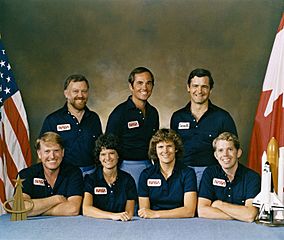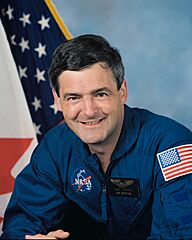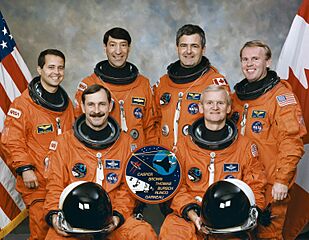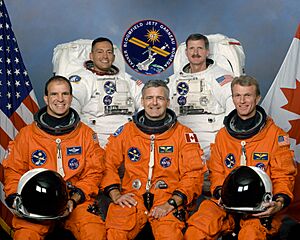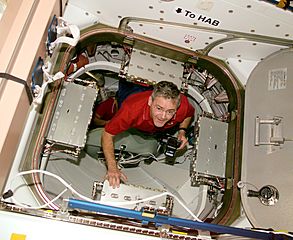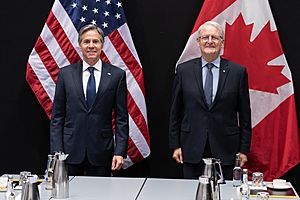Marc Garneau facts for kids
Quick facts for kids
Marc Garneau
|
|
|---|---|
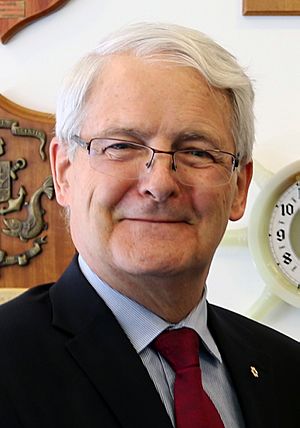
Garneau in 2018 as transport minister
|
|
| Minister of Foreign Affairs | |
| In office January 12, 2021 – October 26, 2021 |
|
| Prime Minister | Justin Trudeau |
| Preceded by | François-Philippe Champagne |
| Succeeded by | Mélanie Joly |
| Minister of Transport | |
| In office November 4, 2015 – January 12, 2021 |
|
| Prime Minister | Justin Trudeau |
| Preceded by | Lisa Raitt |
| Succeeded by | Omar Alghabra |
| Member of Parliament for Notre-Dame-de-Grâce—Westmount Westmount–Ville-Marie (2008–2015) |
|
| In office October 14, 2008 – October 18, 2015 |
|
| Preceded by | Lucienne Robillard |
| Succeeded by | Anna Gainey |
| President of the Canadian Space Agency | |
| In office November 22, 2001 – November 28, 2005 |
|
| Appointed by | Jean Chretien |
| Preceded by | William MacDonald Evans |
| Succeeded by | Laurier J. Boisvert |
| Personal details | |
| Born |
Joseph Jean-Pierre Marc Garneau
February 23, 1949 Quebec City, Quebec, Canada |
| Died | June 4, 2025 (aged 76) Montreal, Quebec, Canada |
| Political party | Liberal |
| Spouses |
Pamela Soame
(m. 1992–2025)Jacqueline Brown
(m. 1973; died 1987) |
| Education |
|
| Military service | |
| Allegiance | |
| Branch | |
| Service years | 1974–1989 |
| Rank | Naval Captain |
| Space career | |
| NRC/CSA astronaut | |
|
Time in space
|
29 days, 2 hours, 1 minute |
| Selection | 1983 NRC Group NASA Group 14 (1992) |
| Missions |
|
|
Mission insignia
|
|
Joseph Jean-Pierre Marc Garneau (born February 23, 1949 – died June 4, 2025) was a Canadian officer, astronaut, and politician. He was the first Canadian to travel into space. Garneau flew on three Space Shuttle missions.
He served as president of the Canadian Space Agency (CSA) from 2001 to 2005. Later, Garneau became a politician. He was elected to the House of Commons in 2008. He served as a Member of Parliament (MP) for a Montreal area until 2023. A member of the Liberal Party, Garneau was Minister of Foreign Affairs in 2021. He was also Minister of Transport from 2015 to 2021.
Born in Quebec City, Garneau joined the Canadian Armed Forces. He earned a degree in engineering physics in 1970. He then served in the navy as a combat systems engineer. In 1973, he received a PhD in electrical engineering. In 1983, Garneau was chosen to be an astronaut. He made history in 1984 as the first Canadian in space. He flew on two more missions after that. He became the head of the Canadian Space Agency in 2001. Garneau left the CSA in 2005 and entered politics. He retired from politics in 2023.
Contents
Early Life and Family
Marc Garneau was born on February 23, 1949, in Quebec City, Quebec, Canada. He came from a military family. His grandfather, Gérard Garneau, was a colonel in World War I. His father, André Garneau, was a French Canadian who served in World War II. His mother, Jean Richardson, was an English Canadian nurse during World War II. She met André while he was in a military hospital. After the war, André continued his military career. He became a brigadier general. Marc was one of four sons in the Garneau family.
Education and Military Career
Because his father moved often for work, Garneau attended many different schools. He studied in Quebec City, Saint-Jean-sur-Richelieu, and London, England. In 1970, he graduated from the Royal Military College of Canada. He earned a bachelor's degree in engineering physics. He then began his career in the Canadian Armed Forces with the navy.
In 1973, he earned a PhD in electrical engineering. This degree was from the Imperial College of Science and Technology in London, England. His research focused on how people see facial images. In 1974, Garneau worked as a naval combat systems engineer. He served aboard the ship HMCS Algonquin.
From 1982 to 1983, he attended the Canadian Forces College in Toronto. He was promoted to the rank of commander. In 1983, he moved to Ottawa. In 1986, he was promoted again to captain. Garneau left the Canadian Forces in 1989.
Space Adventures
On December 5, 1983, Canada announced its first group of astronauts. These astronauts would fly on NASA's Space Transportation System. Marc Garneau was one of six people chosen from over 4,300 applicants. He was the only military officer in this first group. Garneau made history on October 5, 1984. He became the first Canadian to reach space. This happened when the Space Shuttle Challenger flew into orbit.
Garneau's first spaceflight was on the Space Shuttle Challenger. It was part of the STS-41-G mission. This mission lasted from October 5 to 13, 1984. He worked as a payload specialist on this flight. In 1986, he was promoted to Navy Captain. He left the Canadian Forces in 1989. He then became the deputy director of the Canadian Astronaut Program. From 1992 to 1993, he trained to become a mission specialist. He also worked as a CAPCOM for several shuttle flights. He flew on two more missions: STS-77 (May 19 to 29, 1996) and STS-97 (to the ISS, November 30 to December 11, 2000). In total, he spent 677 hours in space.
On February 1, 2001, Garneau became the executive vice-president of the Canadian Space Agency (CSA). On September 28, 2001, he was appointed president of the CSA. He took on this role on November 22, 2001. Garneau resigned from the Canadian Space Agency on November 28, 2005.
-
Crew members of STS-41-G in 1984
-
Garneau in 1992, training with NASA
-
Garneau floats in the hatchway of Endeavour
Political Career
Marc Garneau served as a Member of Parliament (MP) for over 14 years. He represented two different areas in the Canadian House of Commons. First, he represented Westmount—Ville-Marie. Later, he represented Notre-Dame-de-Grâce—Westmount. His first attempt to win an election was in 2006, but he did not win. He was first elected in 2008. He won his seat by a large number of votes. He was re-elected in 2011. In 2015, he won the election for the new Notre-Dame-de-Grâce—Westmount district.
On November 28, 2012, Garneau announced he would run for leader of the Liberal Party. He withdrew from the race on March 13, 2013. On November 4, 2015, Garneau became the Minister of Transport. This was part of Prime Minister Justin Trudeau's government. He became Minister of Foreign Affairs on January 12, 2021.
Early Steps in Politics (2006–2008)
Garneau left his job as president of the Canadian Space Agency. He wanted to run for the Liberal Party of Canada in the 2006 election. He ran in the area of Vaudreuil—Soulanges. The Liberal Party's support in Quebec had decreased. Even though Garneau was a well-known candidate, he lost the election.
In 2007, Garneau showed interest in running in the Outremont area. However, another candidate was chosen instead. Later, Garneau decided to run in Westmount—Ville-Marie. He won this seat in the 2008 federal election. He won by more than 9,000 votes.
Serving in Parliament
Garneau was a member of the Industry, Science and Technology committee. He also worked with the Canada-Japan interparliamentary group. He was re-elected in the 2011 election. He served as the Liberal foreign affairs critic starting in 2013.
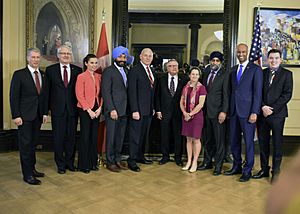
On November 28, 2012, Garneau announced he would run for leader of the Liberal Party. He focused on the economy during his campaign. He was seen as a main challenger to Justin Trudeau. On March 13, 2013, Garneau withdrew from the leadership race. He then supported Justin Trudeau. On September 18, 2013, Garneau became a co-chair for the Liberal International Affairs Council of Advisors. He advised on foreign and defense issues.
Minister of Transport (2015–2021)
In the 2015 election, Garneau was re-elected as an MP. On November 4, 2015, Prime Minister Justin Trudeau appointed him Minister of Transport. In May 2017, Garneau introduced a new law. This law was called the airline passenger bill of rights. It set rules for how airlines must treat passengers. It included rules for compensation for overbooking or lost luggage. It also set standards for delays and cancellations.
In March 2019, after the crash of Ethiopian Airlines Flight 302, Garneau made a decision. He agreed to ground all Boeing 737 MAX aircraft in Canadian airspace. This meant these planes could not fly in Canada. This decision was made after other countries had already grounded the planes.
Minister of Foreign Affairs (2021)
Garneau continued as Minister of Transport after the 2019 elections. He was in charge during the first two years of the Covid-19 pandemic. He helped enforce the Quarantine Act. He made many decisions that affected travelers.
Garneau then served as Minister of Foreign Affairs from January 12, 2021, to October 26, 2021. Prime Minister Justin Trudeau changed his Cabinet on January 12, 2021. Garneau became Minister of Foreign Affairs. Many people thought Garneau was a very skilled member of the Cabinet.
Retirement from Politics (2021–2023)
After the election in October 2021, Garneau was not appointed to a Cabinet position. This happened even though he was re-elected as an MP. Some people thought it was because of his age.
On March 8, 2023, Garneau announced he would resign his seat. He retired from politics. He gave his farewell speech in the House of Commons that same day. A new election was held to replace him. Liberal Anna Gainey won the seat.
Later Life and Passing
After retiring, Garneau continued to support human spaceflight. He believed it was important for monitoring Earth and for communications. In autumn 2024, his autobiography was published in Canada. It was titled A Most Extraordinary Ride: Space, Politics and the Pursuit of a Canadian Dream.
In early 2025, Garneau was diagnosed with cancer. He passed away in Montreal on June 4, 2025, at age 76. After his death was announced, members of the Canadian House of Commons held a moment of silence. His first wife, Jacqueline Brown, passed away in 1987. He is survived by his second wife, Pam Garneau, and his four children.
Awards and Honours
Marc Garneau received many awards for his service.
- He was appointed an Officer of the Order of Canada in 1984. This was for being the first Canadian astronaut.
- In 2003, he was promoted to Companion within the Order of Canada. This was for his extensive work with Canada's space program.
- He received the Canadian Forces' Decoration.
- He also received the 125th Anniversary of the Confederation of Canada Medal in 1993.
- He was awarded the Queen Elizabeth II Golden Jubilee Medal in 2002.
- In 2012, he received the Queen Elizabeth II Diamond Jubilee Medal.
Two high schools are named after him: Marc Garneau Collegiate Institute in Toronto and École secondaire publique Marc-Garneau in Trenton, Ontario. He was also the Honorary Captain of the Royal Canadian Sea Cadets. A Royal Canadian Air Cadets squadron is also named in his honour.
Garneau received the Key to the City of Ottawa on December 10, 1984. He was inducted into the International Space Hall of Fame in 1992.
Honorary Degrees
Garneau received several honorary degrees from universities:
- Royal Military College of Canada (1985)
- Technical University of Nova Scotia (1985)
- Laval University (1985)
- Royal Military College Saint-Jean (1990)
- University of Ottawa (1997)
- University of Lethbridge (2001)
- York University (2002)
- Concordia University (2004)
- McMaster University (2005)
- Athabasca University (2006)
- British Columbia Institute of Technology (2006)
See also
 In Spanish: Marc Garneau para niños
In Spanish: Marc Garneau para niños


